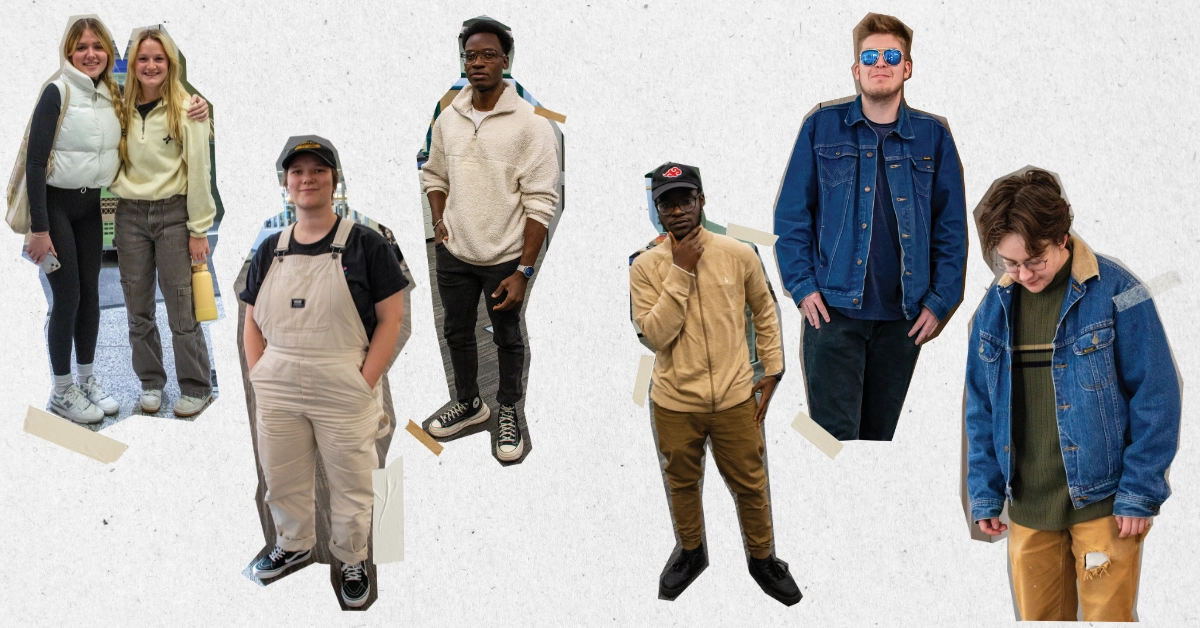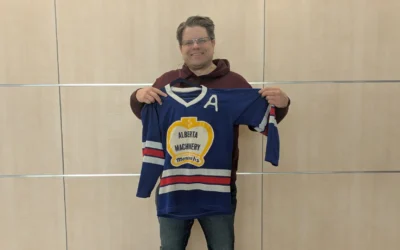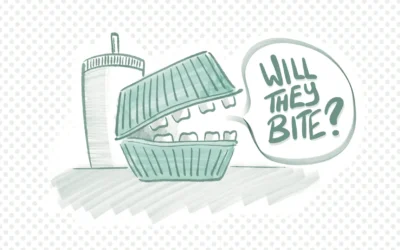Thrifting culture in Edmonton has become quite the phenomenon, encouraging shoppers to pick up old clothing pieces.
Edmonton is known for many things: donairs, nightlife, and hockey. But, why isn’t fashion on the list? Unlike some other Canadian cities, specifically Toronto and Vancouver which are famous for their own eccentric and clothing culture, Edmonton is still far behind when it comes to its sense of style.
There are, of course, the die-hard thrifting fans in the city. The ones who will sit at the Goodwill donation bins from dawn to dusk, hoping to find a cool band tee with no more than two rips and three stains, but no less than a loose thread.
Jake Ferbey, owner of Edmonton’s vintage hotspot Wild Rose Vintage, explains that his love of vintage threads started in high school. In 2009, he and his friends got really into skiing and would go to Value Village to look for ski pants. “There was where it began,” he says, “and then it just kind of evolved from that.”
Rob Yamada, owner and founder of New Life Clothing — an Edmonton used and reworked clothing and vintage store — had a slightly different start. He admitted that as a teenager, he used to go thrifting by himself every now and then to find Halloween costumes and simple pieces like jackets. Because of his interest in fashion, working in the retail industry, and spending time at his mom’s clothing store, his love for clothing continued to grow.
“I love to see the city evolving…to the point where people are getting really specific in what they like in the vintage world.”
Jake Ferbey, owner and founder of Wildrose Vintage
Madison Kustaski, owner and operator of Vintage Valentine — her online vintage and secondhand shop — has had a passion for the fashion industry since she was a teenager working retail jobs. Sheeven considered going to fashion school. For the future, she’s hoping to open her own physical store, and maybe even find a space to set up vintage markets in the city.
Between consigning and thrifting, and vintage and secondhand, the industry of old and used clothes can be confusing. For the average consumer, they just don’t know where to start. “That’s the thing that I find has been misconstrued with a lot of people — they get thrifting and vintage mixed up,” Ferbey says. Just because you buy something at a Value Village, that doesn’t necessarily mean it’s vintage. So, what’s really the difference between vintage clothing and thrifted clothing? “Vintage defined is 20 years and older,” he reveals.
Thrifting, on the other hand, is simply buying secondhand clothing. It’s often more about trying to get a good deal rather than seeking out a specific clothing piece. “If you’re vintage shopping.… you’re shopping for pre-curated businesses that took the time to organize it, source it, and wash [it],” Yamada explains. “There’s a lot more that goes behind it.”
“Do research and donate to the right places.”
Madison Kustaski, owner and operator of Vintage Valentine
If you’re thinking that you aren’t cut out for thrifting, you’re wrong; it really has no criteria. You don’t need to own the nicest pieces, become a fashion mogul, or be like Meryl Streep’s assistant from the Devil Wears Prada. You just need to have an open mind and jump in headfirst.
Over the past few years, Edmonton’s vintage and thrifting scene has gotten a lot better. People are starting to play with their fashion sense more and really open up stylistically. With the constant stream of social media and fashion posts, the perception of “trendy” clothes can be distorted, but that’s the thing about shopping vintage: anyone and everyone can have their own piece of the experience. And in the city specifically, we’re becoming a part of the culture. “Edmonton is on the up,” Yamada says.
“I think I have noticed more on social media with people talking about it…when I work at markets, I see a wide range of people and ages, genders, styles and aesthetics,” Kustaski says. “There’s definitely a growing market for it.”
Becoming open to more styles and the idea of used clothing is a big development for Edmonton. “Now that thrifting seems cool and people wanna do it, I think it’s good for the industry as a whole,” Yamada says.
On the other side of the river near Whyte Avenue, Ferbey also admits that he’s started to see more people who are dressed eccentrically and being bold with their style. “It’s so cool,” he says. “I love to see the city evolving…to the point where people are getting really specific in what they like in the vintage world.”
“It’s not just like, the guys wear American Eagle and the girls wear Aritzia. We’re finally getting past that.”
Jake Ferbey, owner and operator of Wildrose Vintage
Although Edmonton may be behind compared to some of the bigger cities in Canada, in the past few years, “it’s grown tremendously,” Ferbey says. “It’s not just, like, the guys wear American Eagle and the girls wear Aritzia. We’re finally getting past that.” At the end of the day, it often doesn’t even come down to the price of clothes. Many might be deterred from thrifting because of the time and effort it takes to seek out the items and because of the overworn look of some of the items. Yet, Kustaski says that those who are willing to put in the time and spend the money for pre-loved clothes are “the people who get it and the people who appreciate it.”
For those who view old clothing as a way to remember the past, the vintage industry is a great way to do just that. “Vintage clothing acts as a form of nostalgia for lots of people,” Yamada says. “They’ll find something and think, ‘I had something similar to this when I was a kid,’ and I think it just brings back different memories depending on the pieces.”
For those people who view thrifted and vintage clothes as dirty or unsanitary, it’s time to grow up. “Can thrifting be gross? Yeah,” Ferbey admits. “But can going to H&M be gross? Absolutely.” It’s all about putting care into your clothing and shopping with intention. If you’re willing to borrow your friend’s already-worn clothes, why not wear vintage clothes? There might be one more stain or rip more than your best friend’s pants have, but it adds character to your wardrobe, and isn’t there something exciting about knowing that your clothing pieces have a story to them?
Kustaski admits that the other side of thrifting — donating or reselling the clothes — is exciting too. “I thrift a lot of my clothes, and even if I buy something [new] and I’m done wearing it, I can still give it another life with someone else,” she says. Just as it can be fulfilling to pick up a rare and well-priced item, it can also be fulfilling to hand your pieces down to a new owner.
“Edmonton is on the up.”
Rob Yamada, owner and founder of New Life Clothing
Edmonton’s used clothing store owners have a very selective process when it comes to finding cool pieces to sell in their shops. Most of the clothing in thrift shops, secondhand, and vintage stores has been saved from being turned into spill rags. For clothes that aren’t able to be resold, they’re often thrown out. The standard process, Ferbey explains, usually consists of someone donating a cotton t-shirt.The graphic is taken out and the cotton gets sent to paint stores for ripping rags. Meanwhile, the graphic goes to the Middle East or another location with uncontrolled landfills to get burned. Kustaski adds that a lot of donations do still end up in landfills and that“it’s unnecessary waste.”
So, it’s important to know where to shop, and where to drop off your clothes. Many Edmonton businesses sort through clothes stored in warehouses before bringing them back to the store, washing them, steaming them, and hanging them up for sale. If you want to avoid this process, visiting curated vintage shops may be the best option for you. Yamada recommends giving thrifting a try, and doing it your way. “And, if you do it and you find that thrifting is not for you, but you still want to find vintage or secondhand clothing, then there’s businesses out there that do all of the dirty work for you.”
“They’ll find something and think, ‘I had something similar to this when I was a kid,’ and I think it just brings back different memories depending on the pieces.”
Rob Yamada, owner and founder of New Life Clothing)
When donating, Kustaski suggests to “do research and donate to the right places.”. If you’re not interested in reselling your clothes, Edmonton has a lot of organizations that need clothing such asValue Village and Goodwill who distribute the items for resale, or Boyle Street and the Mustard Seed who provide low-income individuals with the clothing items.
If there’s one thing that these business owners want people to know about the used clothing industry, it’s that it’s not gross, overpriced, or boring. In fact, it’s quite the opposite. “There’s enough clothes already out there for everybody,” Yamada says. If it’s already lasted 20 years, there’s a good chance that it’ll last 20 more years.
When it comes to used clothing, it’s almost always going to be more affordable, better quality, and have a higher sustainability factor. And that maybe, for Edmonton and the world as a whole, the future of fashion lies in the past.
Photos by Thai Sirikoone





0 Comments